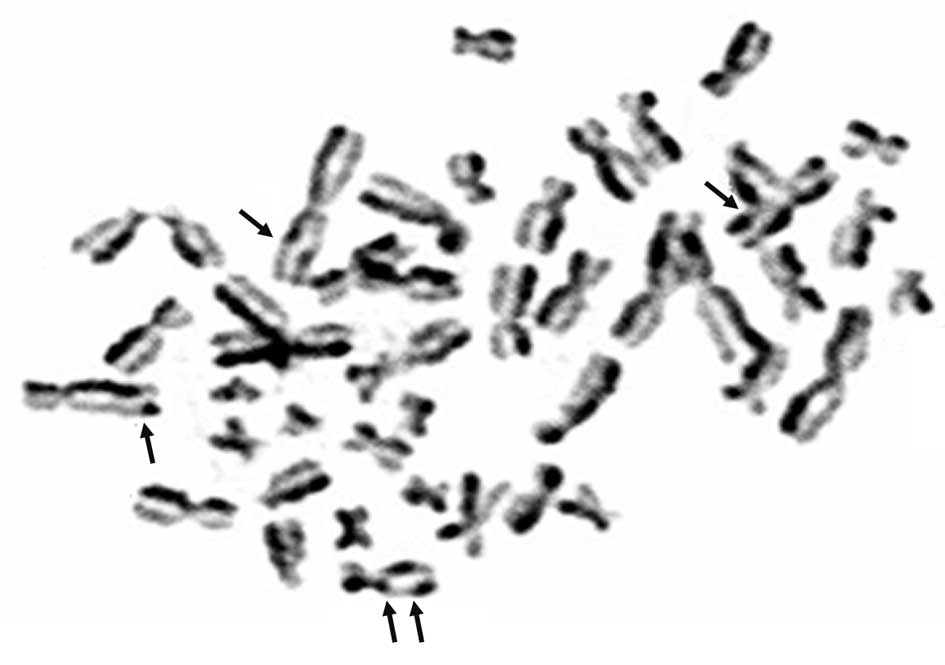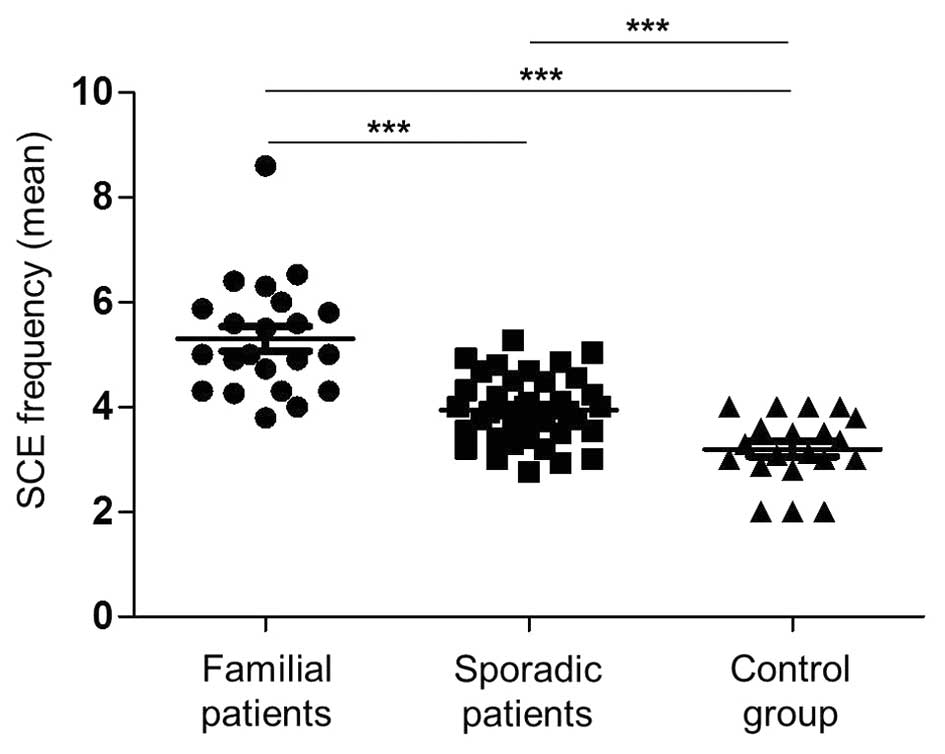|
1
|
Pilato B, Martinucci M, Danza K, Pinto R,
Petriella D, Lacalamita R, Bruno M, Lambo R, D’Amico C, Paradiso A
and Tommasi S: Mutations and polymorphic BRCA variants transmission
in breast cancer familial members. Breast Cancer Res Treat.
125:651–657. 2011. View Article : Google Scholar
|
|
2
|
Levin B, Lech D and Friedenson B: Evidence
that BRCA1- or BRCA2-associated cancers are not inevitable. Mol
Med. 18:1327–1337. 2012. View Article : Google Scholar : PubMed/NCBI
|
|
3
|
O’Donovan PJ and Livingston DM: BRCA1 and
BRCA2: breast/ ovarian cancer susceptibility gene products and
participants in DNA double-strand break repair. Carcinogenesis.
31:961–967. 2010. View Article : Google Scholar
|
|
4
|
Tekcan A, Elbistan M and Ulusoy AN: Sister
chromatid exchanges in breast cancer patients who underwent
chemotherapy. J Toxicol Sci. 37:235–243. 2012. View Article : Google Scholar : PubMed/NCBI
|
|
5
|
Conrad S, Künzel J and Löbrich M: Sister
chromatid exchanges occur in G2-irradiated cells. Cell Cycle.
10:222–228. 2011. View Article : Google Scholar : PubMed/NCBI
|
|
6
|
White JS, Choi S and Bakkenist CJ:
Transient ATM kinase inhibition disrupts DNA damage-induced sister
chromatid exchange. Sci Signal. 3:ra442010.PubMed/NCBI
|
|
7
|
Bozsakyova E, Wsolova L and Chalupa I:
Spontaneous and gamma-ray-induced sister chromatid exchanges in
patients with carcinoma of cervix uteri. Int J Radiat Biol.
81:177–185. 2005. View Article : Google Scholar : PubMed/NCBI
|
|
8
|
Baltaci V, Kayikçioğlu F, Alpas I,
Zeyneloğlu H and Haberal A: Sister chromatid exchange rate and
alkaline comet assay scores in patients with ovarian cancer.
Gynecol Oncol. 84:62–66. 2002. View Article : Google Scholar
|
|
9
|
Dhillon VS and Dhillon IK: Chromosome
aberrations and sister chromatid exchange studies in patients with
prostate cancer: possible evidence of chromosome instability.
Cancer Genet Cytogenet. 100:143–147. 1998. View Article : Google Scholar : PubMed/NCBI
|
|
10
|
Wang LY, Lai MS, Huang SJ, Hsieh CY, Hsu
MM and Chen CJ: Increased sister chromatid exchange frequency in
peripheral lymphocytes of nasopharyngeal carcinoma and cervical
cancer patients. Anticancer Res. 14:105–107. 1994.PubMed/NCBI
|
|
11
|
Dhillon VS, Bhasker R, Kler RS and Husain
SA: Sister chromatid exchange (SCE) studies in breast cancer
patients: a follow-up study. Cancer Genet Cytogenet. 80:115–117.
1995. View Article : Google Scholar : PubMed/NCBI
|
|
12
|
Roy SK, Trivedi AH, Bakshi SR, Patel RK,
Shukla PH, Patel SJ, Bhatavdekar JM, Patel DD and Shah PM:
Spontaneous chromosomal instability in breast cancer families.
Cancer Genet Cytogenet. 118:52–56. 2000. View Article : Google Scholar : PubMed/NCBI
|
|
13
|
Cefle K, Ucur A, Guney N, Ozturk S,
Palanduz S, Tas F, Asoglu O, Bayrak A, Muslumanoglu M and Aydiner
A: Increased sister chromatid exchange frequency in young women
with breast cancer and in their first-degree relatives. Cancer
Genet Cytogenet. 171:65–67. 2006. View Article : Google Scholar : PubMed/NCBI
|
|
14
|
Aristei C, Stracci F, Guerrieri P, Anselmo
P, Armellini R, Rulli A, Barberini F, Latini P and Menghini AR:
Frequency of sister chromatid exchanges and micronuclei monitored
over time in patients with early-stage breast cancer: results of an
observational study. Cancer Genet Cytogenet. 192:24–29. 2009.
View Article : Google Scholar : PubMed/NCBI
|
|
15
|
Mangia A, Chiriatti A, Tommasi S,
Menolascina F, Petroni S, Zito FA, Simone G, Schittulli F and
Paradiso A: BRCA1 expression and molecular alterations in familial
breast cancer. Histol Histopathol. 24:69–76. 2009.
|
|
16
|
Wolff AC, Hammond ME, Schwartz JN, Hagerty
KL, Allred DC, Cote RJ, Dowsett M, Fitzgibbons PL, Hanna WM, Langer
A, McShane LM, Paik S, Pegram MD, Perez EA, Press MF, Rhodes A,
Sturgeon C, Taube SE, Tubbs R, Vance GH, van de Vijver M, Wheeler
TM and Hayes DF: American Society of Clinical Oncology/College of
American Pathologists guideline recommendations for human epidermal
growth factor receptor 2 testing in breast cancer. J Clin Oncol.
25:118–145. 2007. View Article : Google Scholar
|
|
17
|
Perry P and Wolff S: New Giemsa method for
the differential staining of sister chromatids. Nature.
251:156–158. 1974. View
Article : Google Scholar : PubMed/NCBI
|
|
18
|
Hagmar L, Bonassi S, Stromberg U, Brogger
A, Knudsen LE, Norppa H and Reuterwall C: Chromosomal aberrations
in lymphocytes predict human cancer: a report from the European
Study Group on Cytogenetic Biomarkers and Health (ESCH). Cancer
Res. 58:4117–4121. 1998.PubMed/NCBI
|
|
19
|
Barale R, Chelotti L, Davini T, Del Ry S,
Andreassi MG, Ballardin M, Bulleri M, He J, Baldacci S, Di Pede F,
Gemignani F and Landi S: Sister chromatid exchange and micronucleus
frequency in human lymphocytes of 1,650 subjects in an Italian
population: II. Contribution of sex, age, and lifestyle. Environ
Mol Mutagen. 31:228–242. 1998. View Article : Google Scholar : PubMed/NCBI
|
|
20
|
Kumar JV, Saraswathi T, Ranganathan K,
Umadevi K, Joshua E and Rooban T: Sister chromatid exchanges in
smokers and smokers with alcohol habit. J Oral Maxillofac Pathol.
16:338–342. 2012. View Article : Google Scholar : PubMed/NCBI
|
|
21
|
Celik DA, Koşar PA, Ozçelik N and Eroğlu
E: Cytogenetic finding of breast cancer cases and in their
first-degree relatives. J Breast Cancer. 16:285–290. 2013.
View Article : Google Scholar : PubMed/NCBI
|
|
22
|
Ben Salah G, Kamoun H, Rebai A, Ben
Youssef A, Ayadi H, Belghith-Mahfoudh N, Fourati A, Ayadi H and
Fakhfakh F: Sister chromatid exchange (SCE) and high-frequency
cells (HFC) in peripheral blood lymphocytes of healthy Tunisian
smokers. Mutat Res. 719:1–6. 2011. View Article : Google Scholar
|
|
23
|
Bernardes de Jesus B and Blasco MA:
Telomerase at the intersection of cancer and aging. Trends Genet.
29:513–520. 2013. View Article : Google Scholar : PubMed/NCBI
|
|
24
|
Jacobs PA, Maloney V, Cooke R, Crolla JA,
Ashworth A and Swerdlow AJ: Male breast cancer, age and sex
chromosome aneuploidy. Br J Cancer. 108:959–963. 2013. View Article : Google Scholar : PubMed/NCBI
|
|
25
|
Trenz K, Lugowski S, Jahrsdörfer U, Jainta
S, Vogel W and Speit G: Enhanced sensitivity of peripheral blood
lymphocytes from women carrying a BRCA1 mutation towards the
mutagenic effects of various cytostatics. Mutat Res. 544:279–288.
2003. View Article : Google Scholar : PubMed/NCBI
|
|
26
|
Kim MK, Zitzmann S, Westermann F, Arnold
K, Brouwers S, Schwab M and Savelyeva L: Increased rates of
spontaneous sister chromatid exchange in lymphocytes of
BRCA2+/− carriers of familial breast cancer clusters.
Cancer Lett. 210:85–94. 2004. View Article : Google Scholar : PubMed/NCBI
|











